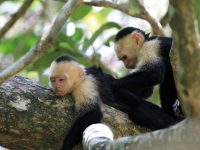
Chimpanzees (Pan troglodytes) are, along with bonobos (Pan paniscus), the closest living relatives of our own species. We share 98.8 % of our genome with them, their gestation period is also nine months, and they are a cooperative species capable of learning by observation (their visual memory may be even better than ours). They also play, smile, cry, etc.
Four subspecies of chimpanzees have been described: eastern (P. t. schweinfurthii), central (P. t. troglodytes), Nigeria-Cameroon (P. t. ellioti) and West African (P. t. verus). It is estimated that there are between 170,000 and 300,000 chimpanzees worldwide. Unfortunately, their natural populations are declining. The International Union for Conservation of Nature has listed them as «endangered». In particular, the West African subspecies – the one pictured here – is listed as «critically endangered». Deforestation, human expansion and poaching are among the factors responsible. In the Republic of Guinea, the Chimpanzee Conservation Center (CCC) sanctuary is working to protect and conserve this subspecies.
Photographing chimpanzees is a contemplative exercise. At first you ignore your camera and enjoy the experience with your own eyes. As soon as you regain full consciousness, you increase the ISO and push the shutter speed to the limit, so that none of the photographs are blurred. Then you begin to capture every gesture, every interaction between them or with the environment. In front of you is a species that is as curious and suspicious as you are. This was not the case with Toto, whose yawn betrayed his calmness. He is one of more than sixty chimpanzees rescued by the CCC and currently kept in its outdoor facilities. Their ultimate goal is to release as many chimpanzees as possible into the wild.





